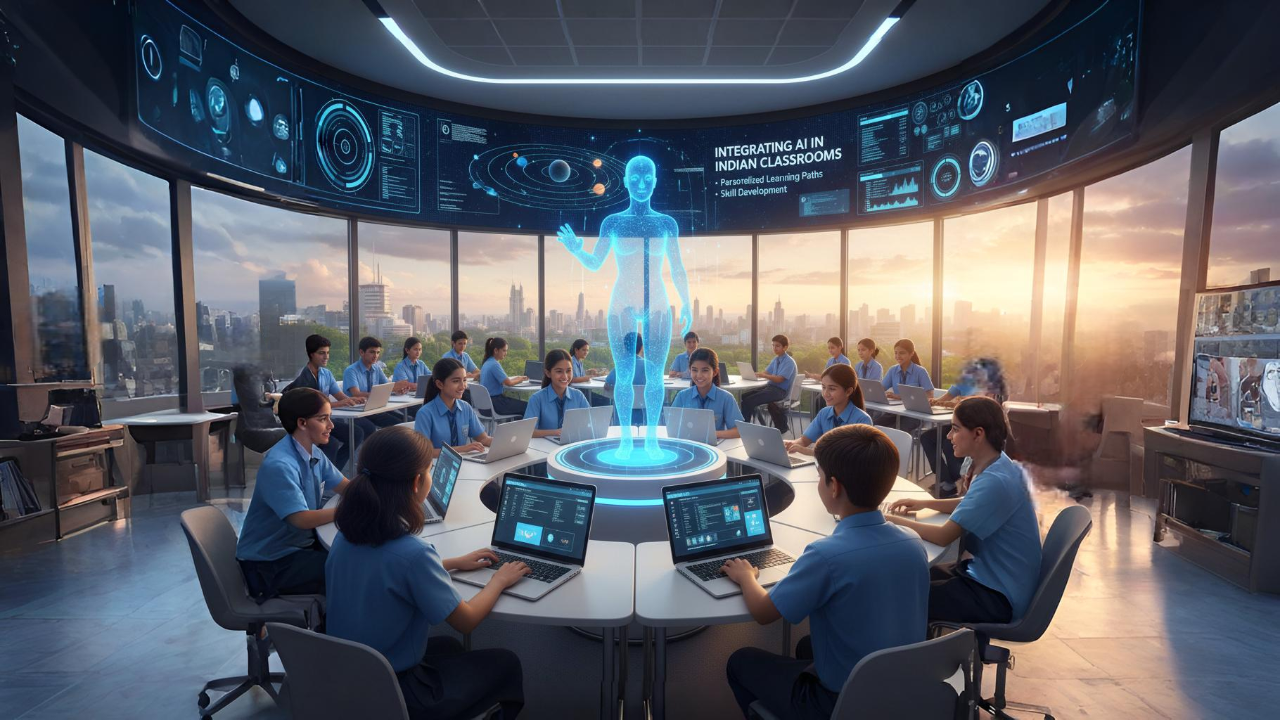Integrating AI in Indian Classrooms


News:
Recently, India has witnessed a surge in the adoption of AI in classrooms, with initiatives like OpenAI’s first office, India AI Mission, and teacher training programs in Delhi aiming to enhance teaching quality, digital literacy, and inclusive education. But can AI truly transform learning, or will challenges and ethical dilemmas hold it back?
Arguments in Favor of Integrating AI in Indian Classrooms
1. Enhances Teaching and Learning Quality
AI tools enable teachers to design pedagogy and curricular content tailored to student needs, improving learning outcomes and engagement.
- Example: Teachers using AI-assisted lesson plans can create interactive modules for diverse learners, making classrooms more dynamic and effective.
2. Prepares Students and Teachers for Future Skills
Integrating AI equips both teachers and students with digital literacy and tech-savvy capabilities essential for the modern workforce.
- Example: Approximately 70% of Indian school teachers are already tech-savvy (Central Square Foundation), easing AI adoption and fostering future-ready classrooms.
3. Bridges the Digital Divide
AI infrastructure and training initiatives provide equitable access to quality education, ensuring all students and teachers can meaningfully participate in the digital world.
- Example: India AI Mission’s “Future Skills” pillar trains teachers to use AI tools ethically and effectively.
4. Promotes Innovation and Creativity
By automating routine tasks, AI allows teachers and students to focus on critical thinking, problem-solving, and imaginative learning experiences.
- Example: AI-assisted grading systems free up teachers’ time to mentor students and design creative classroom activities.
5. Supports Large-Scale Educational Transformation
AI can democratize learning, reduce disparities, and improve overall teaching quality across regions, contributing to socio-economic development.
- Example: Cloud-based AI tools allow students in remote areas to access high-quality educational resources, enhancing equality in learning opportunities.
6. Facilitates Personalized Learning
AI systems can track student progress, identify learning gaps, and provide tailored feedback, improving individual performance.
- Example: Adaptive learning platforms help students struggling in mathematics receive personalized exercises, boosting comprehension and confidence.
7. Reduces Administrative Burden on Teachers
AI tools can handle routine tasks like grading, attendance, and report generation, allowing teachers to focus on teaching and mentorship.
- Example: Automated grading systems free teachers from repetitive tasks, letting them invest more time in interactive classroom activities.
Arguments Against Integrating AI in Indian Classrooms
1. Undermines Pedagogical Essence
Over-reliance on AI technology risks reducing teaching quality to the mechanical delivery of information, weakening empathy, dialogue, and trust between teachers and students.
- Example: Superficial use of AI, such as showing videos or slides, does not guarantee meaningful engagement or critical understanding.
2. Raises Ethical and Academic Concerns
Uncritical adoption of AI can lead to unfair academic practices, plagiarism, and diminished learning integrity.
- Example: CBSE advisories against ChatGPT use in board exams prevent misuse and preserve academic fairness.
3. Exacerbates Digital Inequalities
Students and teachers without adequate technology access and resources may be left behind, deepening the educational divide significantly.
- Example: Urban schools with robust internet and devices integrate AI easily, while rural schools struggle to benefit.
4. Demoralizes Teachers and Students
Treating AI as a substitute rather than a tool can undermine teacher authority and student engagement, reducing motivation and creative participation.
- Example: Teachers relying solely on AI-generated content may lose confidence in their ability to inspire and guide students.
5. Threatens Long-Term Educational Autonomy
Heavy dependence on foreign AI platforms may compromise the development of localized, culturally sensitive, and ethical educational content.
- Example: Overreliance on tools like ChatGPT could neglect India-specific curriculum needs, languages, and pedagogical philosophies.
6. Encourages Superficial Learning
Students may rely on AI-generated answers instead of critical thinking, reducing deep understanding and analytical skills.
- Example: Overuse of ChatGPT for assignments can prevent students from developing problem-solving abilities.
7. May Increase Teacher Dependency
Excessive reliance on AI tools can make teachers dependent on technology, weakening pedagogical judgment and professional expertise.
- Example: Teachers using AI to plan all lessons may lose initiative to innovate or adapt teaching methods independently.
Conclusion:
AI in Indian classrooms offers immense potential to enhance teaching quality, foster creativity, and bridge the digital divide. However, uncritical adoption risks undermining pedagogy, ethics, and educational equity. Balanced integration, ethical use, and teacher empowerment are essential to ensure AI strengthens learning while preserving human-centric education.